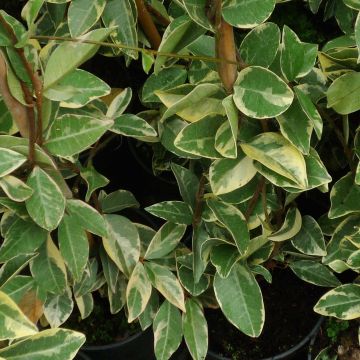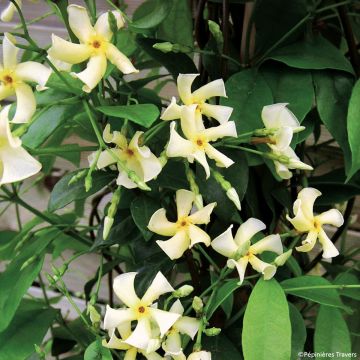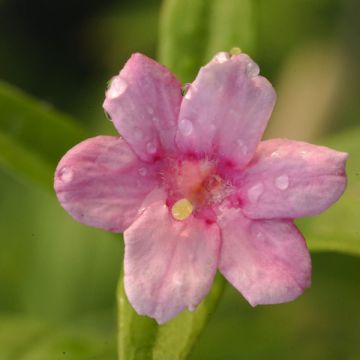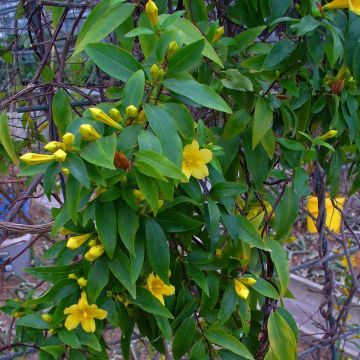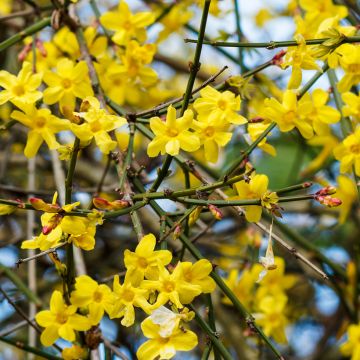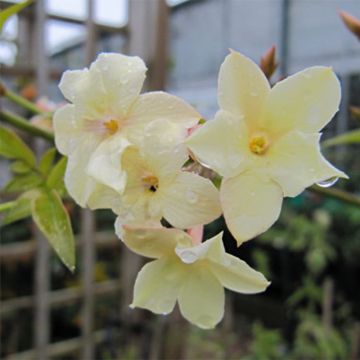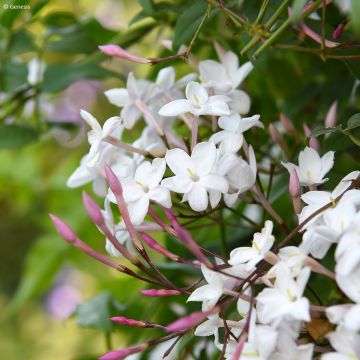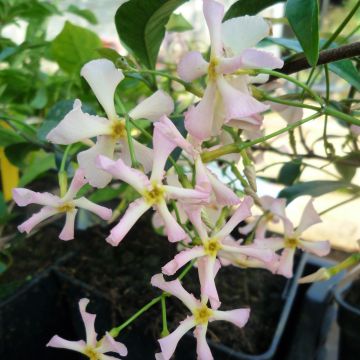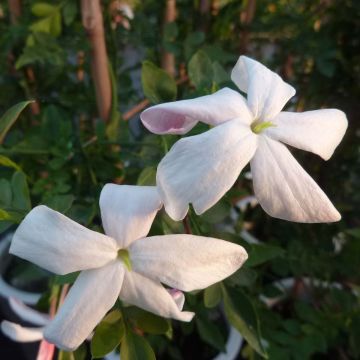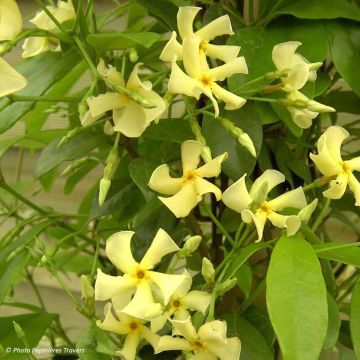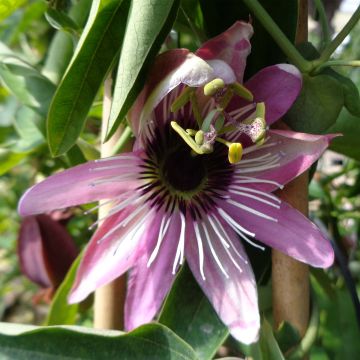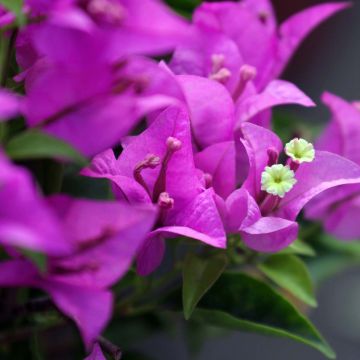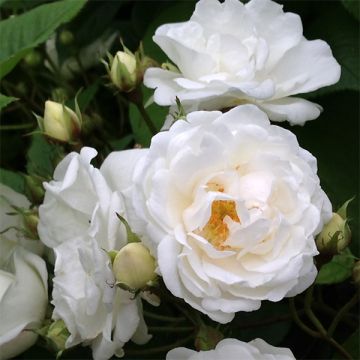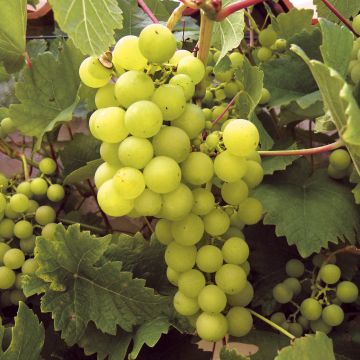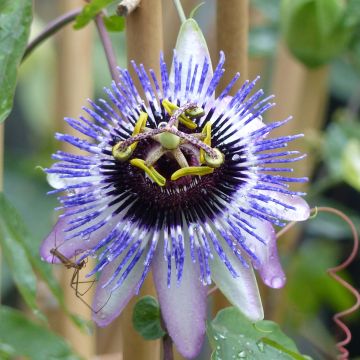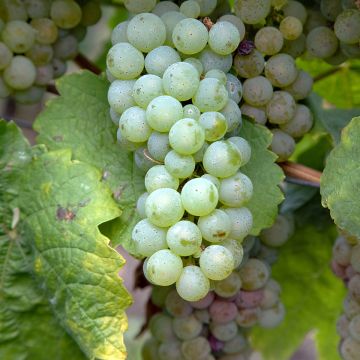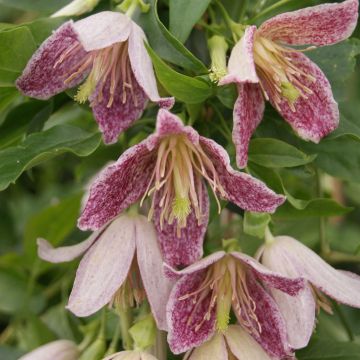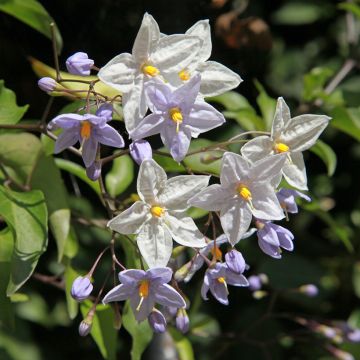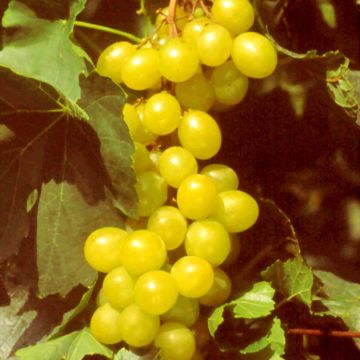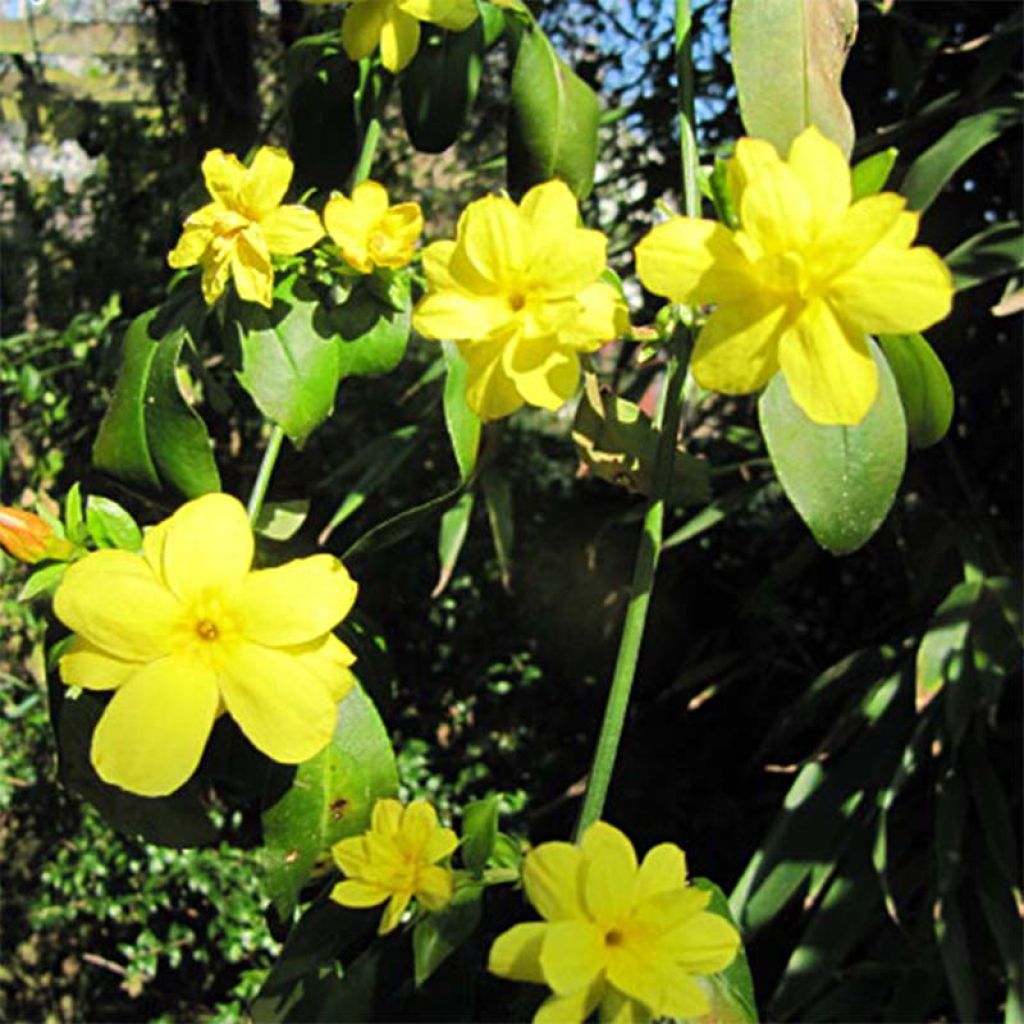

Jasminum mesnyi - Primrose Jasmine
Jasminum mesnyi - Primrose Jasmine
Jasminum mesnyi
Primrose Jasmine, Japanese Jasmine
This item cannot be shipped to the selected country
Delivery charge from €5.90
More information
Schedule delivery date,
and select date in basket
This plant carries a 6 months recovery warranty
More information
We guarantee the quality of our plants for a full growing cycle, and will replace at our expense any plant that fails to recover under normal climatic and planting conditions.
From €5.90 for pickup delivery and €6.90 for home delivery
Express home delivery from €8.90.
Does this plant fit my garden?
Set up your Plantfit profile →
Description
Jasminum mesnyi (synonym J. primulinum) is known by the lovely name of Primrose Jasmine, perhaps because of the resemblance of its yellow flowers to those of wild primroses and because they bloom like them, as early as the end of winter. This floriferous botanical species is also appreciated for its beautiful presence in the garden throughout the year: its broad, dense, and shiny dark green foliage persists in winter in mild climates and perfectly enhances the trumpet-shaped flowers, often semi-double and large for a jasmine. It is a beautiful plant that can be pruned as a bush or trained on a support. Outside of the mildest areas, this jasmine can be grown without difficulty in a large pot, to be stored away in winter to enjoy its flowering, which is sensitive to frost.
The Primrose Jasmine belongs to the olive family. It is native to China (Yunnan province) and Vietnam. In nature, this plant grows on rocky slopes or in thickets, in rather harsh conditions. Not very hardy, this jasmine can be grown in the ground in areas where the temperature does not drop below -10°C/-12°C (10.4°F) for short periods, but its growth and flowering will be affected from -5°C (23°F).
This vigorous bush has rapid growth and a diffuse habit. Its long, stiff, green, and square-sectioned branches do not naturally cling to a support, they need to be trained. An alternative is to prune it after flowering: it will then form a large, dense bush about 1.5m (5ft) in all directions. Flowering begins in February in mild climates and can last until April. Sometimes there is a slight second bloom in autumn, weather permitting. The plant produces solitary flowers with tubular corollas, single or semi-double, measuring 3 to 5cm (1 to 2in) in diameter. They are a pure and bright yellow, with a very subtle fragrance. The abundant foliage is composed of leaves divided into 3 large ovate leaflets, dark green and shiny. It will persist on the plant until -7°C (19.4°F), in a sheltered position from the wind.
If guided in its growth, Jasminum mesnyi climbs on shrubs, trellises, arches, pergolas, stair railings, or balconies in favourable climates. It may be wise to plant it at the top of a wall, from which it will cascade down in drapes: this avoids the need for extensive training. If, on the other hand, it is maintained through pruning, it forms a beautiful dense bush, which is preferable when grown in a pot and will need to be brought indoors for the winter. Place it on the terrace during the summer, and you can enjoy its generous winter flowering in the conservatory or greenhouse. To accompany it, you could choose, for example, a small-flowered clematis florida ('Alba Plena', 'Bicolor' or 'Cassis') or a winter-flowering evergreen clematis like Clematis cirrhosa.
Report an error about the product description
Jasminum mesnyi - Primrose Jasmine in pictures
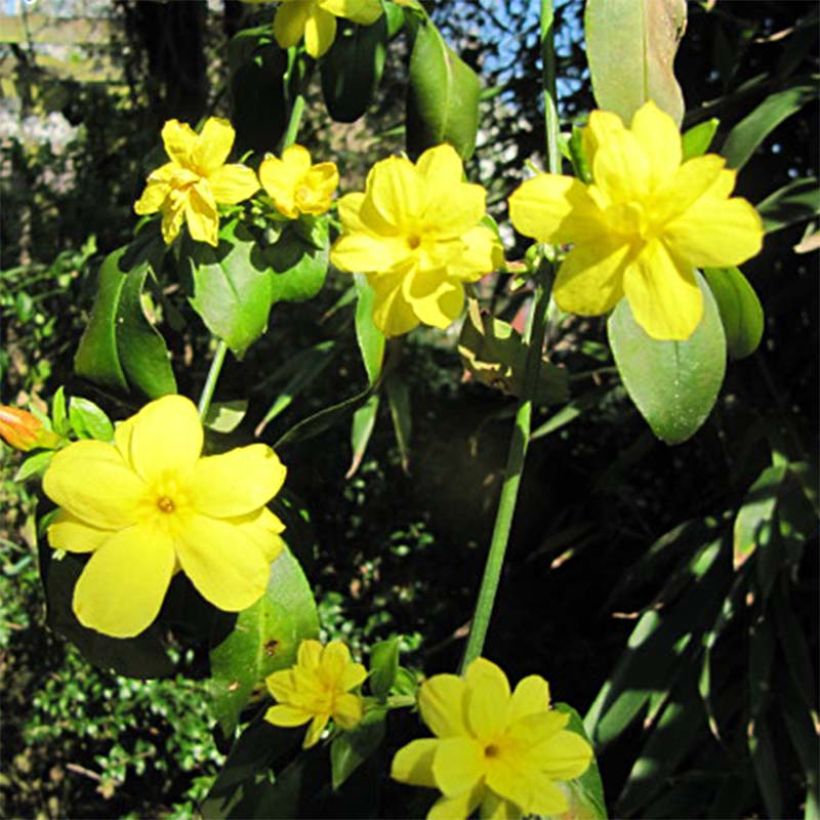

Plant habit
Flowering
Foliage
Botanical data
Jasminum
mesnyi
Oleaceae
Primrose Jasmine, Japanese Jasmine
China
Other Jasmine
Planting and care
Jasminum mesneyi is planted in the ground preferably in spring and in areas with mild winters. While its stump can withstand occasional temperatures of -10/-12°C (14/10.4°F), the vegetation is destroyed at -7°C (19.4°F), along with the flowering that occurs in winter. It can be planted in pots all year round. Plant it in a deep, fertile, loose soil that is kept moist to help it establish. It requires well-drained soil, lightened with compost, and will thrive in a very sunny and sheltered position away from cold winds, or even in partial shade in hot climates. Jasmine tolerates the presence of limestone in the soil fairly well, but not in excess. If winter is dry, water generously as soon as the flowers appear. Prune the oldest stems (brown) at the end of winter when growth starts. This plant tolerates drought fairly well once established, but will be more luxuriant if the soil remains slightly moist. It can tolerate partial shade, but flowering is more abundant in the sun. Avoid exposing it to cold drafts to preserve its flowers. Outside Mediterranean regions or the Atlantic coast, place the jasmine against a south-facing wall that will give it some warmth.
For pot cultivation: choose a container of 50cm (20in), with good, rich, moist, and light soil, specifically for Mediterranean plants. From early spring to mid-September, enrich with liquid fertiliser every 15 days, always on moist soil. In summer, it does not need excessive watering, as its growth period is mainly in winter and spring: water regularly, but not excessively. Jasmine is very vigorous even in a pot and can become sparse at the base. In this case, prune the old branches to leave only 3 young shoots. In winter, place it in a veranda or a cool greenhouse, around 10°C (50°F), with plenty of light. Regularly spray the foliage with lime-free water to prevent attacks from red spider mites.
Planting period
Intended location
Care
-
, onOrder confirmed
Reply from on Promesse de fleurs
Mediterranean climbers
Haven't found what you were looking for?
Hardiness is the lowest winter temperature a plant can endure without suffering serious damage or even dying. However, hardiness is affected by location (a sheltered area, such as a patio), protection (winter cover) and soil type (hardiness is improved by well-drained soil).

Photo Sharing Terms & Conditions
In order to encourage gardeners to interact and share their experiences, Promesse de fleurs offers various media enabling content to be uploaded onto its Site - in particular via the ‘Photo sharing’ module.
The User agrees to refrain from:
- Posting any content that is illegal, prejudicial, insulting, racist, inciteful to hatred, revisionist, contrary to public decency, that infringes on privacy or on the privacy rights of third parties, in particular the publicity rights of persons and goods, intellectual property rights, or the right to privacy.
- Submitting content on behalf of a third party;
- Impersonate the identity of a third party and/or publish any personal information about a third party;
In general, the User undertakes to refrain from any unethical behaviour.
All Content (in particular text, comments, files, images, photos, videos, creative works, etc.), which may be subject to property or intellectual property rights, image or other private rights, shall remain the property of the User, subject to the limited rights granted by the terms of the licence granted by Promesse de fleurs as stated below. Users are at liberty to publish or not to publish such Content on the Site, notably via the ‘Photo Sharing’ facility, and accept that this Content shall be made public and freely accessible, notably on the Internet.
Users further acknowledge, undertake to have ,and guarantee that they hold all necessary rights and permissions to publish such material on the Site, in particular with regard to the legislation in force pertaining to any privacy, property, intellectual property, image, or contractual rights, or rights of any other nature. By publishing such Content on the Site, Users acknowledge accepting full liability as publishers of the Content within the meaning of the law, and grant Promesse de fleurs, free of charge, an inclusive, worldwide licence for the said Content for the entire duration of its publication, including all reproduction, representation, up/downloading, displaying, performing, transmission, and storage rights.
Users also grant permission for their name to be linked to the Content and accept that this link may not always be made available.
By engaging in posting material, Users consent to their Content becoming automatically accessible on the Internet, in particular on other sites and/or blogs and/or web pages of the Promesse de fleurs site, including in particular social pages and the Promesse de fleurs catalogue.
Users may secure the removal of entrusted content free of charge by issuing a simple request via our contact form.
The flowering period indicated on our website applies to countries and regions located in USDA zone 8 (France, the United Kingdom, Ireland, the Netherlands, etc.)
It will vary according to where you live:
- In zones 9 to 10 (Italy, Spain, Greece, etc.), flowering will occur about 2 to 4 weeks earlier.
- In zones 6 to 7 (Germany, Poland, Slovenia, and lower mountainous regions), flowering will be delayed by 2 to 3 weeks.
- In zone 5 (Central Europe, Scandinavia), blooming will be delayed by 3 to 5 weeks.
In temperate climates, pruning of spring-flowering shrubs (forsythia, spireas, etc.) should be done just after flowering.
Pruning of summer-flowering shrubs (Indian Lilac, Perovskia, etc.) can be done in winter or spring.
In cold regions as well as with frost-sensitive plants, avoid pruning too early when severe frosts may still occur.
The planting period indicated on our website applies to countries and regions located in USDA zone 8 (France, United Kingdom, Ireland, Netherlands).
It will vary according to where you live:
- In Mediterranean zones (Marseille, Madrid, Milan, etc.), autumn and winter are the best planting periods.
- In continental zones (Strasbourg, Munich, Vienna, etc.), delay planting by 2 to 3 weeks in spring and bring it forward by 2 to 4 weeks in autumn.
- In mountainous regions (the Alps, Pyrenees, Carpathians, etc.), it is best to plant in late spring (May-June) or late summer (August-September).
The harvesting period indicated on our website applies to countries and regions in USDA zone 8 (France, England, Ireland, the Netherlands).
In colder areas (Scandinavia, Poland, Austria...) fruit and vegetable harvests are likely to be delayed by 3-4 weeks.
In warmer areas (Italy, Spain, Greece, etc.), harvesting will probably take place earlier, depending on weather conditions.
The sowing periods indicated on our website apply to countries and regions within USDA Zone 8 (France, UK, Ireland, Netherlands).
In colder areas (Scandinavia, Poland, Austria...), delay any outdoor sowing by 3-4 weeks, or sow under glass.
In warmer climes (Italy, Spain, Greece, etc.), bring outdoor sowing forward by a few weeks.

































